생후 9~12개월 영아들의 성장 발육, Growth and development of 9~12-month-old infants
생후 9~12개월 영아들의 성장
표 3-4.생후 10개월 된 한국 영아들의 체중과 신장의 백분위수
|
백분위 수
성별 |
3 | 10 | 25 | 50 | 75 | 90 | 97 | |
| 남아 | 체중(kg) | 7.03 | 7.80 | 8.30 | 9.00 | 9.60 | 10.40 | 11.41 |
| 신장(cm) | 67.2 | 69.0 | 70.6 | 72.4 | 75.0 | 77.0 | 80.4 | |
| 여아 | 체중(kg) | 6.75 | 7.40 | 8.00 | 8.50 | 9.20 | 10.0 | 11.00 |
| 신장(cm) | 66.2 | 68.2 | 70.0 | 71.4 | 74.0 | 76.4 | 84.2 |
표 3-5.11개월 한국 영아들의 체중과 신장의 백분위수
|
백분위 수
성별 |
3 | 10 | 25 | 50 | 75 | 90 | 97 | |
| 남아 | 체중(kg) | 7.15 | 8.00 | 8.55 | 9.30 | 10.00 | 10.50 | 11.80 |
| 신장(cm) | 67.6 | 70.2 | 72.1 | 74.2 | 76.3 | 81.0 | 85.0 | |
| 여아 | 체중(kg) | 6.90 | 7.45 | 8.05 | 8.85 | 9.50 | 10.20 | 11.60 |
| 신장(cm) | 66.6 | 68.4 | 70.5 | 72.5 | 75.0 | 78.4 | 85.00 |
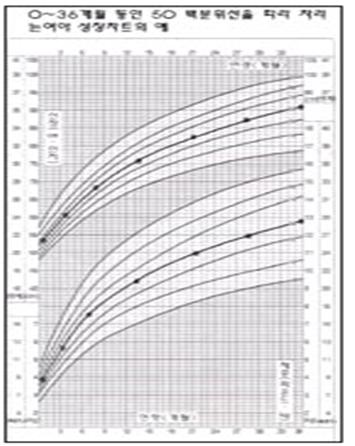
그림 3-98. 0~3세 여 신생아, 영유아들의 성장차트.
신장과 체중이 50퍼센타일 백분위선을 따라 자라는 예의 성장, 신장 백분위선.
Copyright ⓒ 2012 John Sangwon Lee, MD., FAAP
- 생후 9개월에 정기 건강검진을 받고 체중과 신장을 잰다.
- 잰 체중 치와 신장 치를 성장차트 체중·신장 백분위선에 그려본다.
- 체중과 신장이 성장차트 체중·신장 백분위선 어디에 있는지 알아본다.
- 체중치와 신장치가 성장차트 체중·신장 백분위선을 따라 이전과 거의 같은 성장 속도로 계속 정상적으로 성장하는지 알아본다.
- 생후 9개월에서 첫 돌까지 대부분의 영아들의 체중 증가 속도는 생후 9개월 이전 체중 증가 속도에 비해 정상적으로 상당히 느린 것이 정상적이다.
- 1세 체중은 출생 시 체중의 3배정도 된다.
| 생후 9~12개월 영아들의 발육 |
1. 생후 9~12개월 영아들의 신체 발육

사진 3-99. 10개월 된 영아가 혼자 앉아 있다.
Copyright ⓒ 2012 John Sangwon Lee, MD., FAAP

사진 3-100. 10개월 된 영아가 혼자 앉아 있다.
Copyright ⓒ 2012 John Sangwon Lee, MD., FAAP
- 생후 9~12개월 영아들의 젖니는 6~8개정도 난 있거나 한두 개 나 있을 수 있다.
- 거의 대부분의 영아들은 혼자서 앉고 설 수 있다.
- 몸을 앞으로 꾸부려 무엇을 손으로 잡을 수 있다.
- 대부분의 영아들은 뒤뚱거리며 도움 없이 혼자 걸을 수 있다.
- 일부는 의자 등 가구를 붙들고 서고 걷는다.
- 생후 9~12개월 영아들의 대부분은 어디든지 올라가려고 애쓰고 올라갔다가 내려오는 장난치기를 좋아한다.
2. 생후 9~12개월 영아들의 손 발육
- 장난감을 손으로 잡고 흔들고, 양손에 쥔 장난감으로 서로 부딪쳐보기도 하고, 자기가 가진 장난감을 다른 사람에게 건네줄 수 있다.
- 손가락으로 작은 장난감을 전보다 더 잘 집을 수 있다.
- 손에 닿는 것은 무엇이든 입에다 넣기를 좋아한다.
- 입 안에 들어갈 수 있고 기도 속으로 흡인될 수 있는 작은 장난감을 가지고 놀지 않게 한다.
- 공을 굴리고 던질 수 있다.
- 이 시기 영아들은 양손 중 한쪽 손을 더 현저하게 더 많이 쓴다.

사진 3-101. 엄마 아빠의 손을 잡고 걷는 영아.
Copyright ⓒ 2012 John Sangwon Lee, MD., FAAP

사진 3-102. 엄마 아빠의 손을 잡고 걷는 영아.
Copyright ⓒ 2012 John Sangwon Lee, MD., FAAP
3. 생후 9~12개월 영아들의 언어 발육
- 대부분의 영아들은 이 시기에 즐겁게 말을 매일 배운다.
- ‘그것 이리 줘’ 등의 말을 하면 그 뜻을 어느 정도 알아듣고 손에 가지고 있는 것을 건네 줄 수 있다.
- ‘아니’ ‘빠이빠이’ ‘따따’ ‘엄마’ 등 단어를 써서 말을 할 수 있는 영아들도 있고 그런 말을 반복할 수 있다.
- 크게 울어 자기를 돌보아 달라고 요구할 수 있다.
- 빠이빠이 하면서 손을 흔들 수 있다.
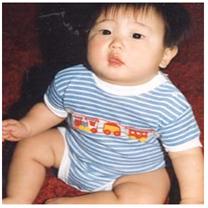
사진 3-103.10개월 된 영아가 혼자서 꼿꼿이 앉아 있다. Copyright ⓒ 2012 John Sangwon Lee, MD., FAAP
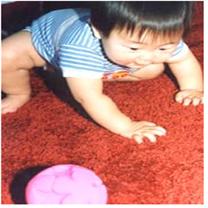
사진 3-104. 9~12개월 된 영아가 공을 가지고 혼자 논다. Copyright ⓒ 2012 John Sangwon Lee, MD., FAAP
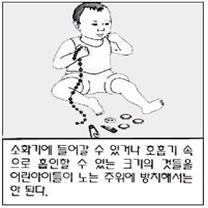
그림 3-105. 기도 속에 이물이 들어가지 않게 예방한다. Copyright ⓒ 2012 John Sangwon Lee, MD ., FAAP

그림 3-106. 영유아들이 화학물질에 중독되지 않게 예방한다. Copyright ⓒ 2012 John Sangwon Lee, MD., FAAP
4. 생후 9~12개월 영아들의 사회성 발육
- 이 시기 영아들의 일부는 엄마 아빠로부터 떨어져 혼자 있기를 아주 싫어하고 혼자 잠자는 것도 아주 싫어한다.
- 분리 공포와 불안, 어둠에 대한 무서움 등으로 자다가 자주 깨는 영아들도 있다.
- 그 때문에 부모들이 잠을 편안히 잘 잘 수 없다.
- 때로는 이런 수면문제로 소아청소년과에 상담하러 오는 부모들도 있다.
- 엄마나 아빠나 다른 사람의 도움이 없이 아기 혼자서 장난감 등을 가지고 잠시 동안 혼자 놀 수 있다.
- 혼자 가서는 안 될 위험한 장소나, 가기 어려운 곳이나 가서 안 될 곳에 가려고 떼를 쓰기도 한다.
- 책상 위나 밥상 위에 있는 물건, 연필이나 음식물 등을 바닥에 떨어뜨린 다음 그것을 집어 올리면서 장난치기를 좋아한다.
- 엄마 아빠가 노는 것을 보고 좋아하면 같은 장난을 반복해서 엄마 아빠를 웃기기도 하고 자신도 웃으면서 장난치기를 좋아한다.
- 거울에 비친 자신의 얼굴 영상을 보면서 거울이 있는 자신에게 아기 말도 하고 장난감을 주기도 한다.
- 도리도리를 할 수 있고 옷을 입고 벗는 것을 장난으로 생각하고 옷을 입힐 때 팔다리를 뻗쳐 옷을 쉽게 입을 수 있도록 도와줄 수 있다[부모도 반의사가 되어야 한다-소아가정간호백과] 제19권 소아청소년 안과 질환-시력검사 참조, 시력검사).

사진 3-107. 혼자서 공을 가지고 놀 수 있다. Copyright ⓒ 2012 John Sangwon Lee, MD., FAAP

사진 3-108. 영아 자신이 스스로 손으로 쥐어 먹게 훈련시킨다. 이런 식으로 독립심을 길러 주기 시작한다.
Copyright ⓒ 2012 John Sangwon Lee, MD., FAAP
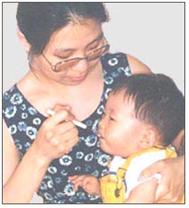
사진 3-109. 엄마가 포근히 안고 눈길로, 신체적 접촉으로 사랑하면서 숟가락으로 먹인다.
Copyright ⓒ 2012 John Sangwon Lee, MD, FAAP
(“생후 1개월~6세의 영유아들의 발육표” )
| 생후 9~12개월 영아들의 장난감 |
장난감 참조
| 생후 9~12개월 영아들의 영양 |
1. 모유수유
- 돌까지 모유를 수유해도 된다.
- 1일 3번 정도 모유를 수유 할 수 있다. 그보다 더 적게 또는 더 여러 번 수유 할 수 있다.
- 이 시기에 모유만 먹으면 필요로 하는 영양분과 에너지를 충분히 섭취할 수 없다.
- 모유를 먹는 영아에게 엄마 아빠가 먹는 밥상 음식물도 먹이고 모유도 먹이고 인공영양, 이유식을 충분히 균형 잡히게 먹인다.
- 첫 돌까지 또는 첫 돌 이후 몇 달 동안 모유 이 외 다른 음식물을 균형 잡히게 잘 먹는 영유아에게 모유 수유를 해도 좋으나 이 나이에는 모유를 더 이상 수유하지 말고 이유할 수 있다.
2. 인공영양

사진 3-110. 이유 연습용 컵으로 주스, 물 등을 마신다. Copyright ⓒ 2012 John Sangwon Lee, MD ., FAAP

사진 3-111. 이유 연습용 컵으로 액체 이유식을 마신다. Copyright ⓒ 2012 John Sangwon Lee, MD., FAAP
- 인공영양을 첫 돌까지 하루 3번 정도 먹인다.
- 이유식과 식구들이 먹는 밥상 음식물을 잘 먹고 소화를 잘 시키면 첫 돌까지 인공영양을 먹이는 것도 좋다.
3. 이유식
- 이미 요리해서 파는 영아 이유식을 사서 먹일 수도 있고,
- 신선한 음식물 재료로 이유식을 집에서 요리해서 먹일 수 있다.
- 엄마 아빠가 먹는 밥상 음식물을 먹기 좋게 요리해서 생후 9~12개월 영아들에게 조심히 먹일 수 있다.
- 씹지 않고 넘길 수 없는 단단하고 질기고 큰 덩어리 음식물은 영아에게 먹여서는 안 된다.
- 영아의 나이와 성장 발육의 성숙도에 따라 밥상 음식물을 잘 골라 조심히 먹여야 한다.
- 잘 씹어 먹을 수 있게 젖니가 많이 나 있지 않기 때문에 밥상 음식물을 먹일 때는 9~12개월 영아가 먹기에 알맞게 요리해서 먹여야 한다.
- 1일 3회 주식을 먹이고 주식과 주식 사이에 간식을 1일 3번 정도 먹인다.
- 9~12개월 영아들은 자신이 수저나 손으로 음식물을 먹기 좋아한다.
- 바닥이나 밥상 위가 음식물로 지저분해지고 손 얼굴 등에 음식물을 묻히는 것이 보통이다.
- 주스, 물, 또는 그 외 음료수는 우유병으로 먹이지 말고 이유 연습용 컵이나 보통 컵으로 먹인다.
- 이유식도 숟가락이나 손으로 먹게 한다.
- 인공영양이나 주스 이유식이나 액체 이유식을 넣은 젖병을 빨면서 재우면 충치가 생기기 쉽고 중이염 또는 축농증(부비동염)이 생기기 쉽다.
- 이때 영아들은 먹기 좋아하는 음식물과 먹기 싫어하는 음식물을 확실히 알아 분별력 있게 먹인다.
- 자기가 좋아하는 음식물만 골라 먹을 수 있다.
- 탄수화물, 지방질, 단백질, 비타민, 미네랄, 수분 등 영양분이 골고루 들어 있는 균형 잡힌 영양 음식물을 충분히 골고루 잘 먹여야 한다.
- 야채류 이유식보다 과일류 이유식을 더 좋아하면 과일류 이유식을, 닭고기 이유식보다 쇠고기 이유식을 더 좋아하면 쇠고기 이유식을, 감자 이유식보다 쌀 이유식을 더 좋아하면 쌀 이유식을 먹이는 식으로 균형 잡히게 탄수화물류, 단백질류, 채소류와 과일류 등의 음식물류를 골고루 골라 먹인다.
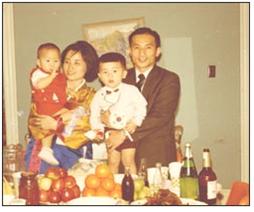
사진 3-112. 자녀에게 생일잔치를 꼭 해준다. 자녀들의 생일을 축하하는 생일잔치를 해주면 부모가 나에게 집중적 관심적 사랑을 갖고 나를 특별히 보살피고 사랑한다고 믿는다.
생일잔치는 집중적 관심적 사랑을 해 주는 방법 중 가장 좋은 방법 중 하나이다.
돌 케이크는 없지만 있는 것은 다 내놓고 돌잔치를 해줬다. Copyright ⓒ 2012 John Sangwon Lee, MD, FAAP
| 생후 9~12개월 영아들의 양호 |
- 다른 사람들이 가진 물건에 많은 호기심을 가질 수 있다.
- 자기의 주위에 있는 것은 무엇이든지 갖고 놀고 만져보고 싶어 한다.
- 그래서 무엇을 쉽게 엎지를 수 있다.
- 밀고 끌고 다니기를 좋아한다.
- 뜨거운 난로, 다리미, 또는 생 전류에 화상 입을 수 있다.
- 높은 곳에서 떨어져 낙상할 수 있다.
- 손에 닥치는 대로 무엇이든지 입에 넣어 중독사고, 기도 속 이물 사고, 위장관 내 이물 사고 등 안전사고가 생기기 쉽다.
- 특별히 안전사고에 주의해야 한다.
- 특히 단추, 못, 또는 안전핀 등 작은 이물이 기도 속으로 흡인되지 않도록 주의하고, 또 청소용 화학물질, 독극물, 약물에 중독되지 않도록 철저히 예방해야 한다.
- 첫돌에 정기 건강검진을 받고 필요에 따라 결핵에 결려 있나 진단하기 위해 투베르쿨린 결핵 피부 반응 검사나 PPD 결핵 피부 반응 검사를 한다.
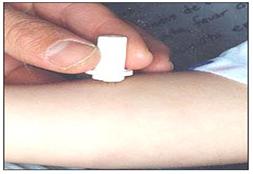
사진 3-113. 결핵에 걸려있나 알아보기 위해 투베르쿨린 결핵 피부 반응 검사를 한다. 여기서 하는 검사는 타인검사이다.
Copyright ⓒ 2012 John Sangwon Lee, MD., FAAP
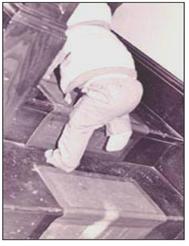
사진 3-114. 계단에 올라가 놀지 않게 주의 한다. Copyright ⓒ 2012 John Sangwon Lee, MD., FAAP

사진 3-115. 계단에 올라가 낙상하지 않게 예방한다. Copyright ⓒ 2012 John Sangwon Lee, MD., FAAP
| 생후 9~12개월 영아 자녀 사랑 |
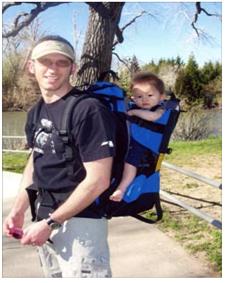
사진 3-116. 요즘 같이 격동하는 이 사회에서 생활하는 중 자녀 하나만 데리고 산보를 가서 시간을 보내면서 집중적, 관심적으로 사랑해 주고 보살펴 주면서 키운다는 것은 그렇게 쉽지 않다.
그러나 부모로부터 받은 집중적 관심적 사랑과 보살핌은 그 자녀의 평생 삶에서 원동력이 된다. 그 값어치는 헤아릴 수 없이 크다. Copyright ⓒ 2012 John Sangwon Lee, MD., FAAP
- 아이들은 엄마 아빠로부터 눈길 접촉사랑, 신체적 접촉사랑, 집중적 관심적 사랑과 보살핌을 충분히 받아야만 정신적으로 육체적으로 건전하게 성장한다. 그리고 건전한 자존심을 갖는다.
- 부모가 그렇게 사랑해 주는 데는 조건도 없고 진정으로 적절히 해야 한다.
- 그런 사랑을 진심으로 하고, 끊임없이 계속 해 주어야 한다.
- 훈련은 사랑으로 해 주어야 한다.
- 그들이 가지고 있는 사랑 탱크를 조건 없는 진정한 그런 사랑으로 철철 넘치도록 채워주어야 한다.
- 그들이 커서 험난한 이 세상에서 사는 동안 소외당할 때, 외로울 때, 불의와 싸울 때, 병마에 시달릴 때, 모욕을 당할 때, 목적 달성을 하기위해 고전 분투를 할 때 자라면서 엄마 아빠로부터 받은 사랑 탱크 속 사랑을 에너지 자원으로 꺼내 쓸 것이다.
- 엄마 아빠는 아이들의 사랑 탱크를 가득히 채워 줄 의무와 권리를 가지고 있다.
- 자녀들은 돈보다 명예보다 이 세상 무엇보다 가장 소중하고 제일가는 부모의 삶의 우선순위이다.
- 자녀들보다 더 귀중한 것이 이 세상에 또 있는가.
- 조건 없고 올바른 사랑을 흠뻑 받고 자라야만 그들은 자신을 사랑할 줄 알고 다른 사람을 사랑할 줄 알고 무엇을 하든지 최선을 다하고 적절하고 건전한 자부심을 가지고 산다.
- 그들은 물론 엄마아빠의 소유물도 아니고 맹장에 달린 충수와 같은 존재도 아니다.
- 그들은 독립된 한 개인이다.
- 그릇된 사랑-소유적 사랑, 역할 전도적 사랑, 유혹적 사랑, 대리적 사랑으로 자녀들을 길러서는 안 된다.
- 엄마 아빠! 나를 사랑하시나요.
- 나를 조건 없이 사랑하시나요. 그리고 나를 진심으로 사랑하시나요?.
- 자녀들은 끊임없이 묻는다.
- 부모 여러분!
- 그들의 질문에 대한 부모님의 답변은 무엇입니까?
- “아닙니까.” 또는 “그렇다.” 입니까.
- 그렇지 않으면 “모르겠다.”라고 답변을 하시겠습니까?
- 이런 질문을 받으시면 “그렇고말고”라고 즉시 답변하실 수 있습니까?
- 걱정하지 마십시오.
- 이 세상에는 완전한 부모들도 없고 완전한 자녀들도 없습니다.
- 부모 여러분!
- 지금이라도, 최선을 다해 자녀들을 조건 없이 진심으로 사랑해서 양육하십시오.
Growth and development of 9-12-month-old infants
Growth of infants 9 to 12 months of age
Table 3-4. Percentiles of weight and height of 10-month-old Korean infants percentile
표 3-4.생후 10개월 된 한국 영아들의 체중과 신장의 백분위수
|
percentile
Gender |
3 | 10 | 25 | 50 | 75 | 90 | 97 | |
| boy | weight(kg) | 7.03 | 7.80 | 8.30 | 9.00 | 9.60 | 10.40 | 11.41 |
| height(cm) | 67.2 | 69.0 | 70.6 | 72.4 | 75.0 | 77.0 | 80.4 | |
| girl | weight(kg) | 6.75 | 7.40 | 8.00 | 8.50 | 9.20 | 10.0 | 11.00 |
| height(cm) | 66.2 | 68.2 | 70.0 | 71.4 | 74.0 | 76.4 | 84.2 |
Table 3-5.11-month-old Korean infants weight and height percentiles표 3-5.11개월 한국 영아들의 체중과 신장의 백분위수
|
percentile
Gender |
3 | 10 | 25 | 50 | 75 | 90 | 97 | |
| boy | weight(kg) | 7.15 | 8.00 | 8.55 | 9.30 | 10.00 | 10.50 | 11.80 |
| height(cm) | 67.6 | 70.2 | 72.1 | 74.2 | 76.3 | 81.0 | 85.0 | |
| girl | weight(kg) | 6.90 | 7.45 | 8.05 | 8.85 | 9.50 | 10.20 | 11.60 |
| height(cm) | 66.6 | 68.4 | 70.5 | 72.5 | 75.0 | 78.4 | 85.00 |

Figure 3-98. Growth chart of newborns and infants aged 0 to 3 years old.
Growth chart of newborns and infants aged 0 to 3 years old.
Example growth where height and weight grow along with the 50th percentile, the height percentile. Copyright ⓒ 2012 John Sangwon Lee, MD., FAAP
• Get regular health checkups at 9 months of age and measure your weight and height.
• Draw the measured weight and height values on the growth chart weight and height percentiles.
• Find out where his weight and height are on the weight and height percentiles of the growth chart.
• Check whether the weight and height continue to grow normally at the same growth rate as before along the weight and height percentiles of the growth chart.
• It is normal for most infants to gain weight from 9 months to the first year of life, which is normally significantly slower than the rate of weight gain before 9 months of age.
• One-year-old weighs about three times the weight at birth.
Development of infants 9 to 12 months of age
1. Physical development of infants aged 9 to 12 months

Picture 3-99. A 10-month-old infant is sitting alone. Copyright ⓒ 2012 John Sangwon Lee, MD., FAAP

Pictures 3-100. A 10-month-old infant is sitting alone. Copyright ⓒ 2012 John Sangwon Lee, MD., FAAP
• Babies aged 9-12 months may have 6-8 or one or two milk teeth.
• Most infants can sit and stand on their own.
• Bend forward to grab something with his hands.
• Most infants wobble and can walk alone without assistance.
• Some stand and walk holding on to furniture, such as chairs.
• Most infants 9-12 months of age like to struggle to climb anywhere and play up and down pranks.
2. Hand development in infants aged 9-12 months
• He can hold a toy in his hand and shake it, hit each other with the toy you hold in both hands, and pass his toy to someone else.
• He can pick up small toys with his fingers better than before.
• Likes to put anything he touches into his mouth.
• Do not play with small toys that can fit in his mouth and be sucked into his airways.
• Can roll and throw the ball.
• At this age, infants use one of their hands significantly more often.

Picture 3-101. Infant holding mom and dad’s hand and walking. Copyright ⓒ 2012 John Sangwon Lee, MD., FAAP

Picture 3-102. Infant holding mom and dad’s hand and walking. Copyright ⓒ 2012 John Sangwon Lee, MD., FAAP
3. Language development of 9-12-month-old infants
• Most infants enjoy learning to speak every day during this time.
• If you say ‘Give me it’, he can understand the meaning to some extent and hand over what he has.
• Some infants can use words such as ‘no’, ‘papa’, ‘tata’, and ‘mom’ to speak, and they can repeat those words.
• May cry out loud and ask for care.
• He can wave his hands while doing Pai Pai.

Picture 3-103. A 10-month-old infant is sitting upright by herself. Copyright ⓒ 2012 John Sangwon Lee, MD., FAAP

Picture 3-104. A 9-12-month-old toddler plays alone with a ball. Copyright ⓒ 2012 John Sangwon Lee, MD., FAAP

Figure 3-105. Prevent foreign objects from entering the airway. Copyright ⓒ 2012 John Sangwon Lee, MD ., FAAP

Figure 3-106. Prevents children from becoming poisnoned to chemicals. Copyright ⓒ 2012 John Sangwon Lee, MD., FAAP
4. Social development of infants aged 9 to 12 months
• Some infants at this age hate being alone away from their mothers and fathers, and they hate sleeping alone.
• Some infants wake up frequently due to fear of separation, anxiety, or fear of the dark.
• Because of this, parents can’t get a good night’s sleep.
• Sometimes parents come to see a pediatrician for sleep problems.
• Your baby can play alone for a while with toys, etc., without the help of mom, dad, or others.
• Sometimes they work in groups to go to dangerous places that they should not go alone, or places that are difficult or not to go.
• Likes to play around by dropping objects, pencils, or food items on the desk or table, and then picking them up.
• If she likes watching her mom and dad play, she repeats the same prank to make her mom and dad laugh, and she likes to laugh and prank herself.
• While looking at the image of one’s own face reflected in the mirror, talk to the person in the mirror and give a toy.
• Able to act, think of putting on and taking off clothes as a joke, and stretching arms and legs when putting on clothes to help them get dressed easily. See Eye Disorders – Optometry, Eye Exam).

Picture 3-107. He can play with the ball by himself. Copyright ⓒ 2012 John Sangwon Lee, MD., FAAP

Picture 3-108. Train infants to hold and eat on their own. In this way, he begin to develop a sense of independence. Copyright ⓒ 2012 John Sangwon Lee, MD., FAAP

Picture 3-109. A mother hugs her and feeds her with a spoon while loving her with her eyes and physical touch. Copyright ⓒ 2012 John Sangwon Lee, MD, FAAP
(“The growth chart of infants from 1 month to 6 years old” )
Toys for babies 9-12 months old- toy reference
Nutrition for infants 9-12 months of age
1. Breastfeeding
• You can breastfeed until 1st birthday
. • You can breastfeed 3 times a day. You can breastfeed less or more times than that.
• If he only eats breast milk during this time, he will not be able to get enough nutrients and energy.
• Feed infants who are breastfed with the food that mother and father eat, breast milk, and artificial nutrition and baby food in a well-balanced manner.
• It is okay to breastfeed an infant who eats a well-balanced diet other than breast milk until the first birthday or for several months thereafter, but at this age, you can wean without breastfeeding anymore.
2. Artificial nutrition

Picture 3-110. Drink juice, water, etc. from a cup for weaning practice. Copyright ⓒ 2012 John Sangwon Lee, MD ., FAAP

Picture 3-111. Drink liquid baby food from a weaning cup. Copyright ⓒ 2012 John Sangwon Lee, MD., FAAP
• Give artificial nutrition about 3 times a day until the first baby.
• If he eats baby food and your family’s table food and digest it well, it’s good to feed artificial nutrition until the first stone.
3. Weaning Baby food
• You can buy and feed baby food that has already been cooked and sold;
• You can cook baby food at home using fresh food ingredients.
• You can carefully feed 9-12-month-old infants by cooking food from mom and dad’s table to be easy to eat.
• Hard, chewy, large chunks of food that cannot be swallowed without chewing should not be fed to infants.
• Depending on the age and maturity level of growth and development of the infant, the food for the table should be carefully selected and fed.
• Since they do not have many teeth to chew and eat, when feeding food from the table, they should be cooked and fed to 9-12 months old infants.
• Feed the stock 3 times a day, with snacks between stocks 3 times a day.
• Babies 9-12 months like to eat with their spoons or hands.
• It is common for the floor or tabletop to become dirty with food and to get food on the hands and face.
• Do not feed juice, water, or other beverages from a bottle, but from a weaning cup or regular cup.
• Eat baby food with a spoon or hands.
• If he sleeps while sucking a bottle containing artificial nutrition or juice baby food or liquid baby food, it is easy to cause tooth decay and otitis media or sinusitis (sinusitis).
• At this time, infants clearly know what they like to eat and what they do not like to eat and feed them judiciously.
• He can eat only the foods he likes.
• A well-balanced, nutritious food that contains nutrients such as carbohydrates, fats, proteins, vitamins, minerals, and water should be fed well and evenly.
• If you prefer fruit baby food to vegetable baby food, eat fruit baby food, if you prefer beef baby food to chicken baby food, eat beef baby food, if he prefers rice baby food to potato baby food, eat rice baby food. Eat a variety of foods, such as vegetables, fruits, and vegetables.

Picture 3-112. Make sure you have a birthday party for your child. I believe that if I have a birthday party to celebrate the children’s birthdays, my parents will have focused attention love, and care. and love for me and take special care and love for me. A birthday party is one of the best ways to show focused attention love and care. There was no stone cake, but they gave out everything they had and had a birthday party. Copyright ⓒ 2012 John Sangwon Lee, MD, FAAP
Good care and parenting for infants 9 to 12 months old
• May be very curious about the things others have.
• Likes to play with and touch anything around them.
• So he can easily spill something.
• Likes to push and drag.
• A hot stove, iron, or live current may burn you.
• He can fall from a high place and fall.
• Safety accidents such as poisoning accidents, foreign objects in the airways, and foreign objects in the gastrointestinal tract are easy to occur by putting anything in your mouth.
• Pay special attention to safety accidents.
• Be especially careful not to aspirate small foreign objects such as buttons, nails, or safety pins into the airways, and thoroughly prevent poisoning with cleaning chemicals, poisons, and drugs.
• In the first year, receive regular health checkups and, if necessary, take a tuberculin tuberculosis skin test or PPD tuberculosis skin test to diagnose tuberculosis.

Picture 3-113. A tuberculin tuberculosis skin test is performed to determine if you have tuberculosis. The test performed here is the other person’s test. Copyright ⓒ 2012 John Sangwon Lee, MD., FAAP

Picture 3-114. Be careful not to climb the stairs and play. Copyright ⓒ 2012 John Sangwon Lee, MD., FAAP

Picture 3-115. Climb the stairs to prevent falls. Copyright ⓒ 2012 John Sangwon Lee, MD., FAAP
9-12 months old infants and children love

Picture 3-116. Living in this turbulent society these days, it is not so easy to take only one child for a walk and spend time intensively loving and caring for them. But the focused, attention love and care they receive from their parents is the driving force in the life of the child. Its value is immeasurably great. Copyright ⓒ 2012 John Sangwon Lee, MD., FAAP
• Children grow mentally and physically soundly only when they receive enough love for eye contact, physical contact, and focused attention love and care from their mothers and fathers. And have healthy self-esteem.
• Parental love is unconditional and genuinely appropriate.
• Such love must be sincere and must be continued.
• Training should be done with love.
• Fill their love tank to the fullest with such unconditional, genuine love.
• When they grow up and live in this harsh world, when they are alienated, when they are lonely, when they fight injustice, when they get sick, when they are insulted, when they struggle to achieve their goals In the tank of love they received from mom and dad growing up, he will use love given by parents as an energy resource.
• Moms and Dads have the duty and right to keep their children’s love tanks full.
• Children are the most precious and most important thing in the world, more than money, more than fame, and the priority of parents’ lives.
• Is there anything in this world more precious than children?
• Only when they are drenched in unconditional and right love must they learn to love themselves, love others, do their best in whatever they do, and live with appropriate and healthy self-esteem.
• They, of course, do not belong to Mom and Dad, nor are they like appendixes to the appendix.
• They are independent individuals.
• Children should not be raised in false love-possessive love, role reversal love, seductive love, or vicarious love.
• mom and dad! do you love me
• Do you love me unconditionally?
And do you really love me?.
• Children constantly ask questions.
• Parents!
• What are the parents’ answers to their questions?
• “No.” or “Yes.” is it.
• Otherwise, would you answer “I don’t know”?
• If you are asked this question, can you immediately answer “no”?
• Do not worry.
• There are no perfect parents and no perfect children in this world.
• Parents!
• Even now, do your best to raise your children with unconditional, heartfelt love.
출처 및 참조문헌
- Nelson Textbook of Pediatrics 22ND Ed
- The Harriet Lane Handbook 22ND Ed
- Growth and development of the children
- www.drleepediatrics.com 제1권 소아청소년 응급 의료
- www.drleepediatrics.com 제2권 소아청소년 예방
- www.drleepediatrics.com 제3권 소아청소년 성장 발육 육아
- www.drleepediatrics.com 제4권 모유,모유수유, 이유
- www.drleepediatrics.com 제5권 인공영양, 우유, 이유식, 비타민, 미네랄, 단백질, 탄수화물, 지방
- www.drleepediatrics.com 제6권 신생아 성장 발육 육아 질병
- www.drleepediatrics.com제7권 소아청소년 감염병
- www.drleepediatrics.com제8권 소아청소년 호흡기 질환
- www.drleepediatrics.com제9권 소아청소년 소화기 질환
- www.drleepediatrics.com제10권. 소아청소년 신장 비뇨 생식기 질환
- www.drleepediatrics.com제11권. 소아청소년 심장 혈관계 질환
- www.drleepediatrics.com제12권. 소아청소년 신경 정신 질환, 행동 수면 문제
- www.drleepediatrics.com제13권. 소아청소년 혈액, 림프, 종양 질환
- www.drleepediatrics.com제14권. 소아청소년 내분비, 유전, 염색체, 대사, 희귀병
- www.drleepediatrics.com제15권. 소아청소년 알레르기, 자가 면역질환
- www.drleepediatrics.com제16권. 소아청소년 정형외과 질환
- www.drleepediatrics.com제17권. 소아청소년 피부 질환
- www.drleepediatrics.com제18권. 소아청소년 이비인후(귀 코 인두 후두) 질환
- www.drleepediatrics.com제19권. 소아청소년 안과 (눈)질환
- www.drleepediatrics.com 제20권 소아청소년 이 (치아)질환
- www.drleepediatrics.com 제21권 소아청소년 가정 학교 간호
- www.drleepediatrics.com 제22권 아들 딸 이렇게 사랑해 키우세요
- www.drleepediatrics.com 제23권 사춘기 아이들의 성장 발육 질병
- www.drleepediatrics.com 제24권 소아청소년 성교육
- www.drleepediatrics.com 제25권 임신, 분만, 출산, 신생아 돌보기
- Red book 29th-31st edition 2021
- Nelson Text Book of Pediatrics 19th- 21st Edition
- The Johns Hopkins Hospital, The Harriet Lane Handbook, 22nd edition
- 응급환자관리 정담미디어
-
소아가정간호백과–부모도 반의사가 되어야 한다, 이상원
-
Neonatal Resuscitation American heart Association
-
Neonatology Jeffrey J.Pomerance, C. Joan Richardson
-
Pediatric Resuscitation Pediatric Clinics of North America, Stephen M. Schexnayder, M.D.
-
Pediatric Critical Care, Pediatric Clinics of North America, James P. Orlowski, M.D.
-
Preparation for Birth. Beverly Savage and Dianna Smith
-
Infectious disease of children, Saul Krugman, Samuel L Katz, Ann A. Gershon, Catherine Wilfert
- 소아과학 대한교과서
- Growth and Development of Children, Eighth Edition, George H. Lowrey, Yearbook Medical Publishers
- Growth and Development of Children, Fifth Edition, E. H. Watson and G. H. Lowrey, Yearbook Medical Publishers
- Other
|
Copyright ⓒ 2015 John Sangwon Lee, MD., FAAP 미국 소아과 전문의, 한국 소아청소년과 전문의 이상원 저 “부모도 반의사가 되어야 한다”-내용은 여러분들의 의사로부터 얻은 정보와 진료를 대신할 수 없습니다. “The information contained in this publication should not be used as a substitute for the medical care and advice of your doctor. There may be variations in treatment that your doctor may recommend based on individual facts and circumstances. “Parental education is the best medicine.” |